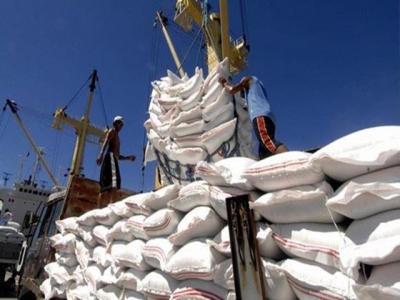Việt Nam to increase rice exports to EU under EVFTA

HÀ NỘI — Rice quotas for Việt Nam under the EVFTA are expected to push Việt Nam’s rice exports up from the second half of this year, according to the Ministry of Industry and Trade (MoIT).
Việt Nam earned $1.71 billion from exporting nearly 3.5 million tonnes of rice in the first half of this year. — Photo doanhnhansaigon
Under the Việt Nam-EU Free Trade Agreement (EVFTA) effective from August 1, the EU pledges to provide an annual rice quota of 80,000 tonnes to Việt Nam and completely liberalise trade in broken rice. After three to five years, tariffs on rice products will be slashed to zero per cent.
Trần Thanh Hải, deputy director of MoIT’s Import and Export Department, said that in 2019, Việt Nam had a modest value at US$10.7 million from rice exports to the EU because of high import tariffs in this market.
At present, the EU’s import tariffs for Vietnamese rice is 175 euros ($198) per tonne of milled rice, 65 euros per tonne of broken rice and 211 euros per tonne of paddy.
"The rice quotas of 80,000 tonnes to Việt Nam according to the commitments in the EVFTA is an opportunity for Việt Nam to enhance its rice exports to this market, which has annual demand of about 2.5 million tonnes of rice," Hải told the Hải quan (Customs) newspaper.
Meanwhile, the EU also sets a range of conditions for those quotas such as origin certificates on Vietnamese rice. The rice exported to EU must have authenticity certificates issued by Vietnamese authorities.
To take advantage, the Ministry of Agriculture and Rural Development (MARD) and the MoIT are compiling a draft decree guiding the registration process for certification of rice categories exported to the EU to submit to the Government for approval.
According to this draft, eligible rice varieties exported to the EU must meet Việt Nam’s technical standards and regulations on quality, region cultivating rice varieties, and processes of harvesting, preserving, grinding, milling and packaging rice.
Phạm Thái Bình, general director of the Trung An High-tech Agriculture Joint Stock Company in Cần Thơ City, said Vietnamese rice reaching those requirements to enter the EU with low tariffs would help Việt Nam increase its rice exports in the future.
"When the tariff for Vietnamese rice is reduced to zero per cent, it gives local rice products more advantages in competing with rice from Cambodia and other countries in the EU market," Bình said.
The agriculture sector expects to significantly increase exports of many key products until 2025 thanks to the EVFTA, such as rice (up 65 per cent), sugar (8 per cent), pork (4 per cent), forest products (3 per cent), and cattle and poultry meat (4 per cent).
However, those products must overcome many trade barriers of the EU, such as technical barriers on origin, product quality and intellectual property protection.
Therefore, experts said that local farmers and businesses in the agriculture sector have to improve production capacity and product quality, find export markets and build brands for agricultural products.
In the long term, strict regulations on quality standards for exported Vietnamese agricultural products, including rice, would force the agriculture sector to undertake comprehensive restructuring in production and business.
According to MARD, Việt Nam earned $1.71 billion from exporting nearly 3.5 million tonnes of rice in the first half of this year, up 17.9 per cent in value and 4.4 per cent in volume year-on-year. In June alone, 409,000 tonnes of rice worth $207 million was shipped abroad.
The Philippines was the top buyer between January and May, importing 1.3 million tonnes of Vietnamese rice worth $598.6 million, or 40 per cent of total rice exports. They were up 23 per cent in volume and 42 per cent in value from a year earlier.
During the first five months, markets to which the value of rice exports enjoyed the strongest year-on-year growth were Senegal (18.3-fold), Indonesia (2.9-fold), and China (2.3-fold).
Meanwhile, rice export prices increased 13 per cent from the same period last year to average $485 per tonne.
Related news
 Production reform, awareness of EU regulation needed among agriculture businesses for EVFTA
Production reform, awareness of EU regulation needed among agriculture businesses for EVFTA With the EU-Việt Nam Free Trade Agreement (EVFTA) coming into effect in August and eliminating most tariffs, agriculture, forestry and aquaculture businesses
 Organic agriculture project adopted
Organic agriculture project adopted The percentage of organic livestock products is expected to reach about 1-2 per cent of the total domestic livestock products.
 Tea businesses need restructuring to add value
Tea businesses need restructuring to add value The Government should build corporations with financial resources to help the domestic tea industry add value, branding and sales, said Chairman of Vietnam Tea